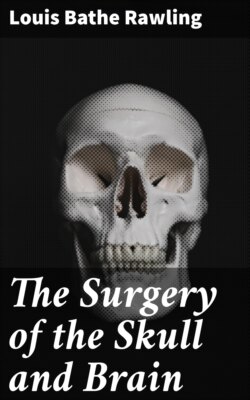Читать книгу The Surgery of the Skull and Brain - Louis Bathe Rawling - Страница 56
На сайте Литреса книга снята с продажи.
Оглавление1. Expectant treatment, combined with the application of pressure.
2. Aspiration and puncture.
3. Free exposure and further treatment according to the conditions found.
In the majority of cases the local conditions preclude any attempt at radical cure—the gap in the skull is large, the margins of the deficiency are thinned and everted, and the brain enters largely into the formation of the projecting mass. Furthermore, the dura mater is torn and in a tag-like condition. Only in the most favourable cases—when the tumour is small and the gap narrow—can radical treatment be advocated.
The application of pressure—without previous aspiration—exercises but little effect on the size of the tumour and, under such treatment, the danger of brain-compression is always present.
Aspiration with the object of removing the fluid constituents of the tumour, and thus of reducing its size, has occasionally been followed by disastrous results. Still, many cases were so treated in the pre-aseptic days, and the modern methods of cleanliness should allow of better results. One or more aspirations may be carried out, this treatment to be followed by the application of steady and uniform pressure, preferably with the aid of elastic bandages, the degree of compression depending on the size and constituents of the tumour. The patient must be watched most carefully, in order to guard against the development of symptoms pointing to cerebral compression. Irritating injections should never be used.
One must acknowledge that this mode of treatment has—except in a few isolated cases—not produced very satisfactory results. Still, since an open operation is usually out of the question, no other course remains.
The after-history of these cases is not very encouraging. In one of Weinlecher’s cases the child was living 5 years later, but pulsation was still present. In Lucas’s case the patient died 21 months later from meningitis. In Sir T. Smith’s case, pulsation was present 3 years after the accident, and in Silcock’s there was no marked change for the better after 11 years. On the other hand, a case reported by Golding Bird steadily improved, and a second case reported by the same writer gave every promise of a permanent cure. The two following cases have come under my own observation:—
1. A female child, 11 months old, was knocked down by a van, and, on admission, a large hæmatoma was seen situated over the right temporo-parietal region. The child was semi-comatose, but recovered consciousness next day. The hæmatoma softening, a gap in the bone was felt, one-third of an inch wide, and extending from the occipital bone upwards and inwards to the middle line. The swelling increased in size when the child cried. Pulsation was present and translucency was obtained. The tumour increased in size for some days, but no untoward symptoms developed. For over one month pressure was applied, but without much benefit, though the general condition of the child was good. The edges of the gap became thickened. The child was then removed from the hospital.
2. A male child fell 19 feet on to his head. He was concussed, and, on admission, presented a hæmatoma over the right fronto-parietal region, and subconjunctival hæmorrhage in the left orbit. Four days later he was apathetic and there was some paresis of the left arm and leg. As the hæmatoma became softer, pulsation was noticed over a small area, and, in this situation, the swelling increased in size on straining. A fracture was detected later, one-third of an inch in diameter, and extending across the left frontal bone to the right temporal region. Pressure was applied, the tumour steadily decreased in size, and eventually the gap was completely closed.
Synopsis of 38 cases of traumatic cephalocele.
Sex. Males, 16. Females, 13. Sex not stated, 9.
Age at time of accident.
2 cases at birth.
9 in the first 6 months.
9 in the second 6 months.
14 between 1 and 2 years of age.
1 between 3 and 10.
1 between 10 and 15.
1 between 15 and 20.
1 between 20 and 30.
Region affected.
Right parietal, 17 cases.
Left parietal, 4 cases.
Other bones, right and left, 8 cases.
Parietal with others, 9 cases.
Parietal bone involved in 30 out of 38 cases.
Right side involved in 27 out of 38 cases.
Date of appearance of tumour.
7 cases in the first week.
11 cases in the second week.
4 cases in the third week.
4 cases between 2 and 18 months.
In the remainder, date uncertain.
